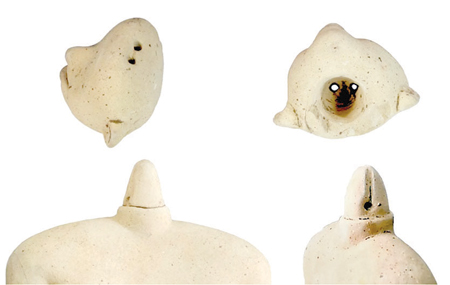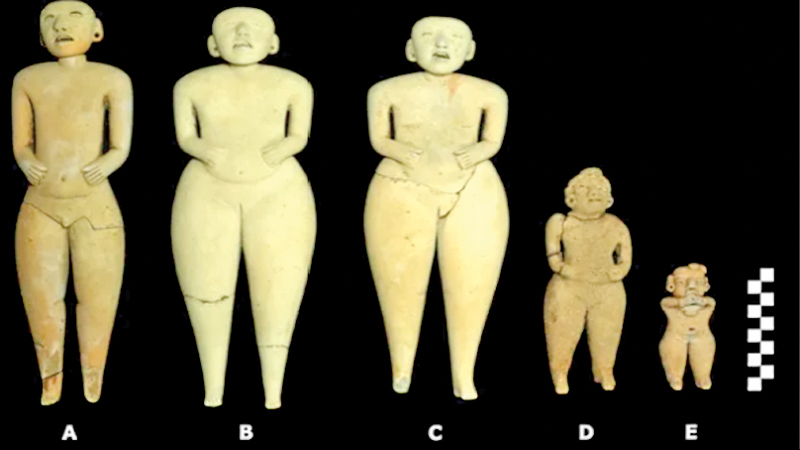 The South American country of El Salvador caught the headlines of many news channels across the world for a remarkable discovery; ceramic puppets atop a pyramid. The latest discovery revealed many aspects, particularly the ancient history of El Salvador and the indigenous peoples of the region.
The South American country of El Salvador caught the headlines of many news channels across the world for a remarkable discovery; ceramic puppets atop a pyramid. The latest discovery revealed many aspects, particularly the ancient history of El Salvador and the indigenous peoples of the region.
Archaeologists have uncovered a bizarre cluster of ceramic puppets at least 2,400 years old on the summit of a pyramid in El Salvador. These puppets had theatrical facial features somewhat reminiscent of the terracotta images of ancient Greek masks.
The five ceramic statuettes of four females and one male have faces that change depending on which angle you view them. This discovery shed light on a type of “public ritual” performed by the territory’s Indigenous people, according to researchers. Three of the ceramic figures stand about three feet tall (30cm), while two others are about 10cm (0.3ft) and 18cm (0.6ft). The larger figurines are bare, with no hair, while the smaller ones are crafted with more detail, with depictions of locks of hair across the forehead and ear spools. Gaping mouths are another notable feature, while some show visible tongues. The largest figurines have removable heads along with tiny holes between its necks and tops.
Ancient marionettes
A key researcher, Jan Szymański, said that threading a string along these holes would create the impression of singing, speaking and chanting figurines, suggesting that they may have been used as an ancient form of puppetry similar to ancient marionettes. While some archaeologists believe that the puppets were used as symbolic representations of humans in public rituals, most believe that they were crafted as a part of a scene of a tableau meant to re-enact stories and bring them to life through a public theatrical setting to communicate narratives from “readily decodable events, mythical or real”.
According to a study published in the journal Antiquity, they were initially found atop the site’s most elevated pyramid structure in 2022. From the eye level, the puppets look angry, while they seem frightened from below and smiling from above.
One of the most unique characteristics of the puppets is their theatrical facial expressions, which alter according to the angle we look at them, said Jan Szymanski, a co-author of the study from the University of Warsaw in Poland. “They are clay actors. When you hold them in your hand, sometimes, they even look creepy because of their vivid expressions,” he said.
Nevertheless, it remains unclear if they symbolise real historical figures or caricatures. It could be a challenge to determine since a massive volcanic eruption of around 400 to 500 CE destroyed the region, emitting 10 times more volcanic fumes and ash compared to the Mount Vesuvius disaster that buried Pompeii.
The statuettes also bear similarity to matching dolls excavated in Guatemala in 2012, where archaeologists discovered six broken and uncovered figurines of females on a burial site in Guatemala’s Western highlands dated to the Middle Pre-classical period suggestive of shared practices between the two elite communities of the ancient cultures.
The latest discovery brings a wealth of information to archaeologists as most of the ruins of El Salvador perished when the Ilopango volcano erupted in 400-500 BCE wiping out all life forms and burying it in ash within a 25 mile radius. Due to these events, and the highly populous nature of the present day cities, excavations have been problematic which has hampered the understanding of the true nature of these discoveries and its origins.
Archaeologists also found other artefacts at the site in El Salvador, including jade pendants baring resemblances to those found in ancient places like Nicaragua and Panama, which is evidence that its residents may have voluntarily traded goods and ideas over extensive distances covering the Mayan Civilisation.
While the puppets are not disclosed to be of Mayan origin, it is believed that the indigenous communities of El Salvador may have had closer links to Mesoamerican cultures than previously thought, while the nature of these indigenous communities still remains a mystery.
Mayans in El Salvador
Before the arrival of the Spanish, El Salvador was inhabited by various Mesoamerican civilisations, with the most prominent being the Maya. The Maya lived in the region for centuries and constructed impressive cities and ceremonial centres. Notable Mayan cities in El Salvador include Tazumal, San Andrés, and Joya de Cerén. Having had advanced systems in agriculture, mathematics, astronomy, and a complex social and religious system, Joya de Cerén was particularly significant, as it was preserved under volcanic ash after an eruption around 600 CE, much like Pompeii in Italy.
The Maya was one of the most advanced civilisations in Mesoamerica and inhabited a large region that includes parts of present-day Southern Mexico, Guatemala, Belize, and El Salvador. Their influence extended into El Salvador, particularly in the Western part of the country.
Though Mayan presence in El Salvador dates back to 1000 BCE, the most prominent Maya cities in El Salvador flourished between the Classical period (250–900 CE) and the Post-Classical period (900–1500 CE). In the Western part of El Salvador, the Lenca people were also prominent, while in the Eastern part, the Pipil Nahua people had their own rich culture.
Shared cultural practice
The ceramic puppets and dolls from both El Salvador and Guatemala are often stylised in human form, with distinct facial features and clothing that may reflect the cultural practices of the time. These figures tend to have exaggerated features, such as large eyes, pronounced mouths, and simple, yet distinctive body shapes that often appear to be symbolic rather than realistic.
 These figurines are not just decorative, but likely played an important ceremonial or ritualistic role. In many Mesoamerican cultures, figurines were used in religious rituals, as offerings to gods or ancestors, or as symbols of fertility and other important aspects of life. They might also represent puppets used in performance, where they could have been part of ritual dramas or ceremonial storytelling, a common practice among ancient cultures in the region.
These figurines are not just decorative, but likely played an important ceremonial or ritualistic role. In many Mesoamerican cultures, figurines were used in religious rituals, as offerings to gods or ancestors, or as symbols of fertility and other important aspects of life. They might also represent puppets used in performance, where they could have been part of ritual dramas or ceremonial storytelling, a common practice among ancient cultures in the region.
The figures may have also been used in funerary practices, buried with the deceased as part of the afterlife rituals, similar to how many Mesoamerican cultures used figurines to accompany their dead on their journey to the next world.
The similarities in these ceramic figures suggest cultural exchange and a shared set of religious beliefs and practices between the ancient Guatemala and the neighbouring cultures in El Salvador, including the Pipil and Maya.
Trade routes across Mesoamerica facilitated the movement of both goods and ideas. This exchange could explain why similar figurines and ceremonial objects were used in different regions of Mesoamerica, including in El Salvador and Guatemala.
The presence of similar ceramic dolls or puppets in both El Salvador and Guatemala suggests a cultural and religious affinity between the two regions. This connection may have involved trade networks with goods, ideas, and cultural practices flowing between the regions, assisted by trade routes that connected different Mesoamerican societies.
The Maya and their neighbours shared a pantheon of gods, myths, and ritual practices, which could have influenced the creation of similar figurines for religious and ceremonial purposes within indigenous communities. The use of puppets in storytelling, performance, and ritual was common in many Mesoamerican societies, while the figurines found in these locations may have played a role in such practices
Roles of ceramic puppets and dolls
Many of these ceramic puppets might have been used in rituals to communicate with gods or spirits, perhaps during agricultural ceremonies or during seasonal changes (e.g., planting and harvest times). The figures may have also been part of theatrical performances, where puppets were used to tell stories, reenact myths, or honour deities, a practice seen in other ancient cultures.
The designs of the puppets could have served as artistic expressions of the spiritual realms, representing gods, animals, or legendary figures. The use of clay as a medium was not just a practical choice but also had symbolic significance, with certain colours or forms potentially representing particular deities or elements of nature.
The dolls might have been buried with the dead or placed in sacred spaces as offerings to ensure a safe journey to the afterlife or to honour ancestors. These rituals were common in many Mesoamerican cultures.
In El Salvador, Joya de Cerén, the “Pompeii of the Americas,” provides insight into the daily lives and ceremonial practices of the region’s ancient inhabitants.
Tazumal and San Andrés also have artefacts that reflect shared Mayan practices, including the use of ceramic objects for ceremonial purposes. In Guatemala, places like Kaminaljuyú and Tikal have also uncovered ceramic puppets and figurines showing striking resemblance to those found in El Salvador, further supporting the theory of cultural exchange.
The figures found at these sites are often connected to Mayan religious practices and may have been used in similar ceremonies to those in El Salvador.




